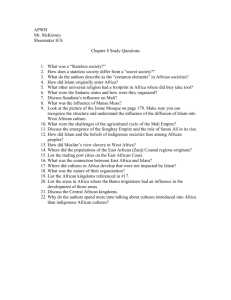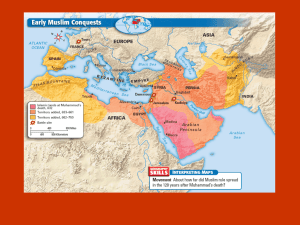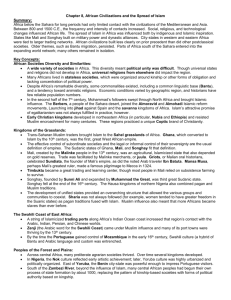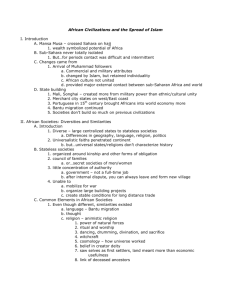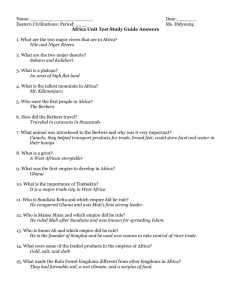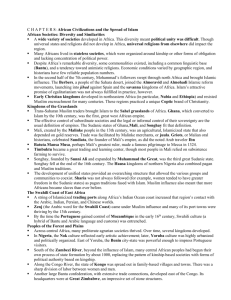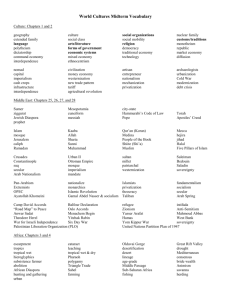Chapter 8 Reading Guide: African Civilizations and the Spread of
advertisement
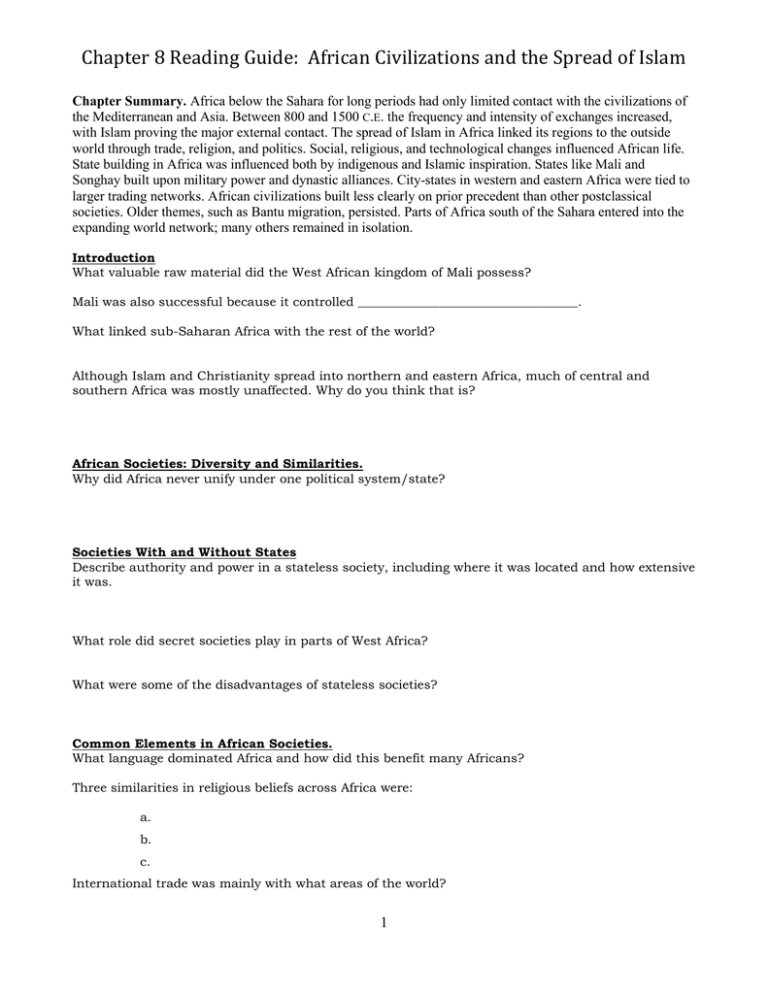
Chapter 8 Reading Guide: African Civilizations and the Spread of Islam Chapter Summary. Africa below the Sahara for long periods had only limited contact with the civilizations of the Mediterranean and Asia. Between 800 and 1500 C.E. the frequency and intensity of exchanges increased, with Islam proving the major external contact. The spread of Islam in Africa linked its regions to the outside world through trade, religion, and politics. Social, religious, and technological changes influenced African life. State building in Africa was influenced both by indigenous and Islamic inspiration. States like Mali and Songhay built upon military power and dynastic alliances. City-states in western and eastern Africa were tied to larger trading networks. African civilizations built less clearly on prior precedent than other postclassical societies. Older themes, such as Bantu migration, persisted. Parts of Africa south of the Sahara entered into the expanding world network; many others remained in isolation. Introduction What valuable raw material did the West African kingdom of Mali possess? Mali was also successful because it controlled ___________________________________. What linked sub-Saharan Africa with the rest of the world? Although Islam and Christianity spread into northern and eastern Africa, much of central and southern Africa was mostly unaffected. Why do you think that is? African Societies: Diversity and Similarities. Why did Africa never unify under one political system/state? Societies With and Without States Describe authority and power in a stateless society, including where it was located and how extensive it was. What role did secret societies play in parts of West Africa? What were some of the disadvantages of stateless societies? Common Elements in African Societies. What language dominated Africa and how did this benefit many Africans? Three similarities in religious beliefs across Africa were: a. b. c. International trade was mainly with what areas of the world? 1 Chapter 8 Reading Guide: African Civilizations and the Spread of Islam The Arrival of Islam in North Africa. Why was Christianity weak and not a unifying force in North Africa at the time Islam moved into the area? Who stopped the expansion of Islam into Western Europe? Where? Jihad was waged by both Almoravids and Almohadis groups and spread Islam into Spain and what other area? Identify the appeal of Islam to both rulers and common people: 1. 2. Islam teaches that men and women are equal. What evidence is given that shows prior patriarchal beliefs held strong in Islamized Africa? The Christian Kingdoms: Nubia and Ethiopia. How was geography important to the spread of Christianity in Northeast Africa? Explain what this structure is, why it was built, and what is unusual about it (i.e., why was it difficult to construct and why it’s impressive). What two outside powers were drawn into a conflict between Muslim states and Christian Ethiopia? What do you think their motivation was for getting involved? What was the end result of this conflict? Kingdoms of the Grasslands. How did geography influence the development of some African states such as Ghana? Include examples of particular resources of the region. (Hint: Why were those states located where they were?) 2 Chapter 8 Reading Guide: African Civilizations and the Spread of Islam Sudanic States. List some of the characteristics the Sudanic states had in common: 1. 2. 3. 4. 5. The Empire of Mali and Sundiata, the “Lion Prince.” Describe the relationship between rulers in the Sudanic states and Islam. Examine carefully the clan structure established by Sundiata. Your text implies there were at least 4 areas of expertise or duty (I’m splitting specialists into two). What were they? Give a SINGLE WORD description/label of each (“griots” is not allowed). 1. 2. 3. 4. Which of those four seems to have been the most important? Explain why that clan was the most important in light of Ibn Batuta’s observations. What is the purpose of this structure located in Jenne? How was contact with the outside world vital to its architectural design? What was the importance of Timbuktu and Jenne to Islam? 3 Chapter 8 Reading Guide: African Civilizations and the Spread of Islam City Dwellers and Villagers What was the connection between strong militaries, trade, and intellectual endeavors in the Sudanic states? Timbuktu enjoys the economic benefits of being located along both a major river and at the entry point of caravan routes across a major physical feature in Africa. What is the river and physical feature? (feel free to Google a map). How might the economic and agricultural circumstances in the region have contributed to the practice of polygamy? The Songhay Kingdom. What military force/technology was used by the Songhay and later Hausa peoples to expand their borders and protect trade routes? Give an example of how the fusion of Muslim and pagan belief sometimes caused tension with devout Muslims in the region. How did technology contribute to the downfall of the Songhay empire? Political and Social Life in the Sudanic States. Sharia law is patrilineal. What accommodation had to be made by devout Muslims in some areas of the Sudan and why? What was the effect of Muslim penetration into sub-Saharan African on slavery? What was the result of the Muslim practice of freeing the children of slave mothers? Over what period of time did the slave trade exist between the Islamic world and sub-Saharan Africa? 4 Chapter 8 Reading Guide: African Civilizations and the Spread of Islam The Swahili Coast of East Africa. What was the connection between Islam and East African cities? Imports to East African cities most often occurred between what months? Exports? (Can’t find it? Hint: LOOK at the map on page 196.) Imports – Exports – The Coastal Trading Ports. A stereotypical image of chimpanzees has them eating bananas. Why have they not always done so? Why was the East African coastal region so cosmopolitan? The Mixture of Cultures on the Swahili Coast. How did Islam contribute to trade between East Africa, India, and Indonesia? Identify the extent to which Islam was adopted in East Africa and among what groups. Swahili is a fusion of what two languages? Peoples of the Forest and Plains. What important feature of most civilizations was lacking in most areas of Africa not exposed to either Christianity or Islam? How was knowledge transmitted in these societies? Artists and Kings: Yoruba and Benin. These terra-cotta sculptures from central Nigeria near the village of Nok provide evidence that a people existed there who valued art. They also reveal that there is a lot we do not know about the area. Why? 5 Chapter 8 Reading Guide: African Civilizations and the Spread of Islam Art from Yoruba peoples was focused on what subject? How were the Yoruba organized? Most of their art was presented in what two mediums besides wood and terra-cotta? How was Benin art similar to Yoruba art? Thinking Historically: Two Transitions in the History of World Population. (198-9) The history of human population has two basic periods. Identify both along with rough time frames. Beginning to – ____________________ was represented by ________________________ growth. The second period began with the introduction of new food sources (from the Americas – the Columbian Exchange) but was mainly due to the _____________________ __________________________ and the discovery of new sources of ____________________________. List significant factors that contributed to the increase in life expectancy: Why has fertility dropped, particularly in Western Europe and U.S.? Give two reasons. 1. 2. Why has Africa’s birth rate not declined? Your book states that one proposed solution to the population growth problem is “a redistribution of resources from rich nations to poor nations.” How likely is that to happen and do you think it would work if it did? Central African Kingdoms. What was the original home of the Bantu speaking peoples? Central African peoples replaced old political systems based on kinship groups with what system? 6 Chapter 8 Reading Guide: African Civilizations and the Spread of Islam The Kingdoms of the Kongo and Mwene Mutapa. Early European explorers believed Phoenicians or Arabs built Great Zimbabwe. Why was this and who did build it? How do we know that the Great Zimbabwe was trading with East African coastal cities? Global Connections: Internal Development and External Contacts. Even though most of Africa did not convert to Islam, this chapter admittedly focuses on the Sudanic states and Swahili coast, two Islamic areas. Why this imbalanced focus? Identify the major raw materials the rest of the world wanted from Africa by the late 15 th century. **DON’T FORGET TO STUDY THE BOLD FACED KEY TERMS IN THE MARGINS.** 7
